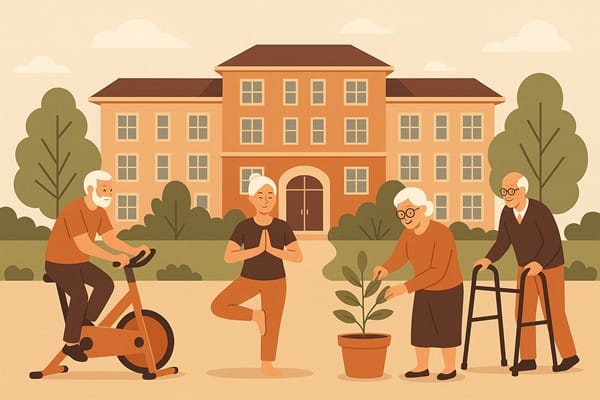It’s normal for our health to decline as we age. That doesn’t happen at the same time for everyone. In fact, some people start to notice minor differences in their physical and mental health when they’re in their 30s while others don’t experience noticeable changes until they’re in their 50s or 60s. That being said, most people see significant transitions in their 60s and beyond. At that point, the effects of time, environmental factors, and other elements begin to accelerate.

Maintaining Your Well-Being in a Senior Living Community
After passing retirement age, people are at a higher risk of developing a long list of physical health issues, including arthritis, high blood pressure, heart disease, diabetes, and osteoporosis to name a few. Mental health issues, such as anxiety and depression, also tend to be more prevalent beyond the age of 60. Cognitive decline and mobility issues are more likely to develop as well.
Studies have shown that people who live alone or don’t have access to all of the medical care they need are generally more susceptible to the effects aging. In contrast, living in a retirement community can reduce those risks. If you’re considering Belmont Village as your new home, take a look at some of the ways senior living communities can foster health and wellness.
Continual Access to Medical Care
For one, retirement communities give residents constant access to the medical care they need to stay healthy. They offer on-site medical care as well as transportation to off-site appointments. At the same time, they have highly trained caregivers on hand to cater to residents’ needs. In a senior living community, you won’t have to worry about scheduling doctors’ appointments, arranging for transportation, physicians and specialists not being available when you need them, and other hurdles.
Nutritious Meals
Many seniors don’t get the nutrients they need. Some are unable to drive to the grocery store when they need to. Others don’t have the dexterity, mobility, or energy to cook meals for themselves. Cognitive decline, depression, and other issues factor into the equation here as well. Inadequate nutrition can cause or exacerbate a wide range of health issues. In a senior living community, nutritious meals will be readily available to you. Whether you dine in the on-site restaurant or cafeteria or have a caretaker help you prepare meals in your apartment, you’ll be less likely to suffer from the effects of malnutrition.
Fitness Classes
Additionally, senior living communities have fitness classes for their residents to take advantage of. Some offer a variety of exercises and activities from aerobics to yoga and beyond. They keep the unique needs of their residents in mind when creating their fitness programs as well. They’ll help you stay fit and healthy without pushing you beyond your limits.
Mental and Emotional Health
Physical health is important, but mental and emotional wellness are equally essential. Retirement communities take that to heart as well. They offer a variety of programs and activities to keep their residents engaged. From arts and crafts to gardening and beyond, they give their residents plenty of fun and interesting ways to pursue hobbies, learn new things, and stay occupied. They offer services tailored to the needs of patients with dementia and other forms of cognitive decline too. Furthermore, they offer an array of events and opportunities for their residents to socialize.
Retirement Communities: Helping You Stay Healthy and Happy
Everyone’s health declines with age. It’s inevitable. Though it’s impossible to avoid physical, mental, and emotional health issues altogether, it’s certainly possible to keep them to a minimum. Having access to the medical care you need, getting proper nutrition, staying physically active, keeping your mind engaged, and socializing are the keys to staying happy and healthy for as long as possible. Many seniors struggle with those factors, but senior living communities help ensure you have all of them right at your fingertips.



